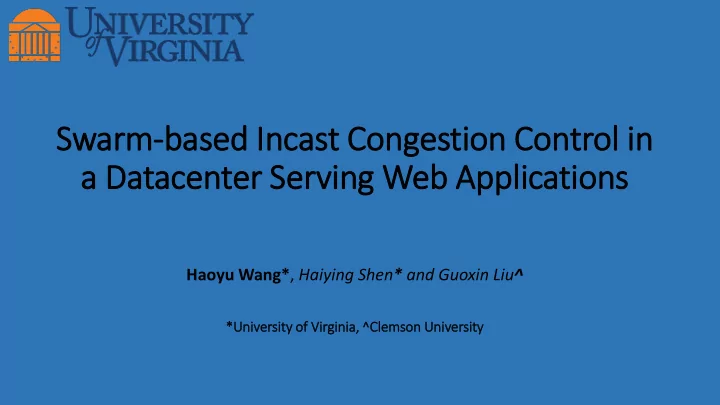

Swarm-based In Incast Congestion Control in in a Datacenter Serving Web Applications Haoyu Wang* , Haiying Shen * and Guoxin Liu ^ *U *Universit ity of of Vir irgin inia ia, ^C ^Cle lemson Univ iversit ity
Outline • Introduction • Approach description • Evaluation • Conclusion 2
Outline • Introduction • Approach description • Evaluation • Conclusion 3
Introduction Incast congestion is a common problem in modern datacenters 1. TCP timeout and retransmission 2. Throughput loss 3. Increased latency 4. Application failure Glenn from Morgan Stanley , NSDI 2015 4
Introduction Incast congestion Incast is a many-to-one communication pattern commonly found in cloud data centers. It begins when a singular parent server places a request for data objects to a large number of servers simultaneously. The Nodes respond to the singular Parent. The result is a micro burst of many machines simultaneously sending TCP data streams to one machine 5
Introduction Incast congestion Incast is a many-to-one communication pattern commonly found in cloud data centers. It begins when a singular parent server places a request for data objects to a large number of servers simultaneously. The servers respond to the singular parent, resulting a micro burst of many machines simultaneously sending TCP data streams to one machine 6
Introduction 7
Introduction Previous work Sliding Window MCN ’95 The window size changes after the congestion is detected ICTCP (Improved sliding window protocol) Staggered flow 8
Introduction Previous work Sliding Window The window size changes after the congestion is detected ICTCP (Improved sliding window protocol) Conext’10 Staggered flow 9
Introduction Previous work Sliding Window The window size changes after the congestion is detected ICTCP (Improved sliding window protocol) Conext’10 Staggered flow MASCOTS ’ 12, COMPSACW’13 10
Outline • Introduction • Approach description • Evaluation • Conclusion 11
Approach Description A multilevel tree with proximity-aware swarm Hub: The server connecting with the font-end server and has the largest spare capacity to handle I/O among each rack 12
Approach Description A swarm structure is formed only for one data request 1. The transient structure does not need to be maintained 2. Transmitting data through a much smaller structure greatly reduces the latency 3. Data servers without requested data objects do not need to participate in the structure Determine a suitable number of hubs: 𝑇 𝑓 𝐶 𝑒 ∗ 𝐶 𝑣 𝑡 ∗ 𝑛 𝑂 = Building multi-level tree of hubs: 1. The hubs under the same aggregation router are linked together in the tree 2. A hub’s child always has a smaller number of requested data objects than its parent 13
Approach Description Pseudocode of multi-level tree generation 1. Cluster target data servers in each rack into a swarm 2. /* Select a hub from each swarm*/ 3. For each swarm do 4. Select the data server with the largest number of requested data objects as the hub; Enqueue the hub into queue 𝑅 ℎ 5. Sort the hubs in 𝑅 ℎ in ascending order of number of requested data objects 14
Approach Description Pseudocode of multi-level tree generation 1. /*Create multi-level tree from hubs*/ 2. While 𝑅 ℎ >N do 3. Dequeue a hub ℎ 𝑗 from 𝑅 ℎ 4. Select a hub ℎ 𝑘 with the smallest number of data objects and under the same aggregation router as ℎ 𝑗 ; Link ℎ 𝑗 as child to ℎ 𝑘 5. While ℎ 𝑘 has less than children and ℎ 𝑗 has children do 6. Transmit the last child from ℎ 𝑗 to be a child of ℎ 𝑘 15
Approach Description Two-level data transmission speed control In order to avoid overloading the front-end server: 1. At the front-end server The front-end server periodically adjusts the assigned bandwidth to each hub after each short time period 2. At the aggregation router For multi front-end servers under the same router, we adjust the request transmission speed of each front-end server 16
Outline • Introduction • Approach description • Evaluation • Conclusion 17
Evaluation Simulation setup: 3000 data servers with fat tree structure TCP retransmission timeout: 10ms Comparison methods: 1. One-all 2. Sliding window protocol (SW) MCN’95 3. ICTCP Conext’10 18
Evaluation Performance of SICC 19
Evaluation Performance of SICC 20
Evaluation Performance of multi-level tree of hubs 21
Evaluation Computing time of multi-level tree generation 22
Outline • Introduction • Approach description • Evaluation • Conclusion 23
Conclusion 1. Incast congestion is a common problem in modern datacenters 2. We proposed Swarm-based Incast Congestion Control method (SICC) 1. Proximity-aware swarm based data transmission 2. Two-level data transmission speed control 3. other enhancements 3. Experiments show that SICC achieves higher throughput and lower latency 24
Conclusion Thank you! Question 25
Recommend
More recommend